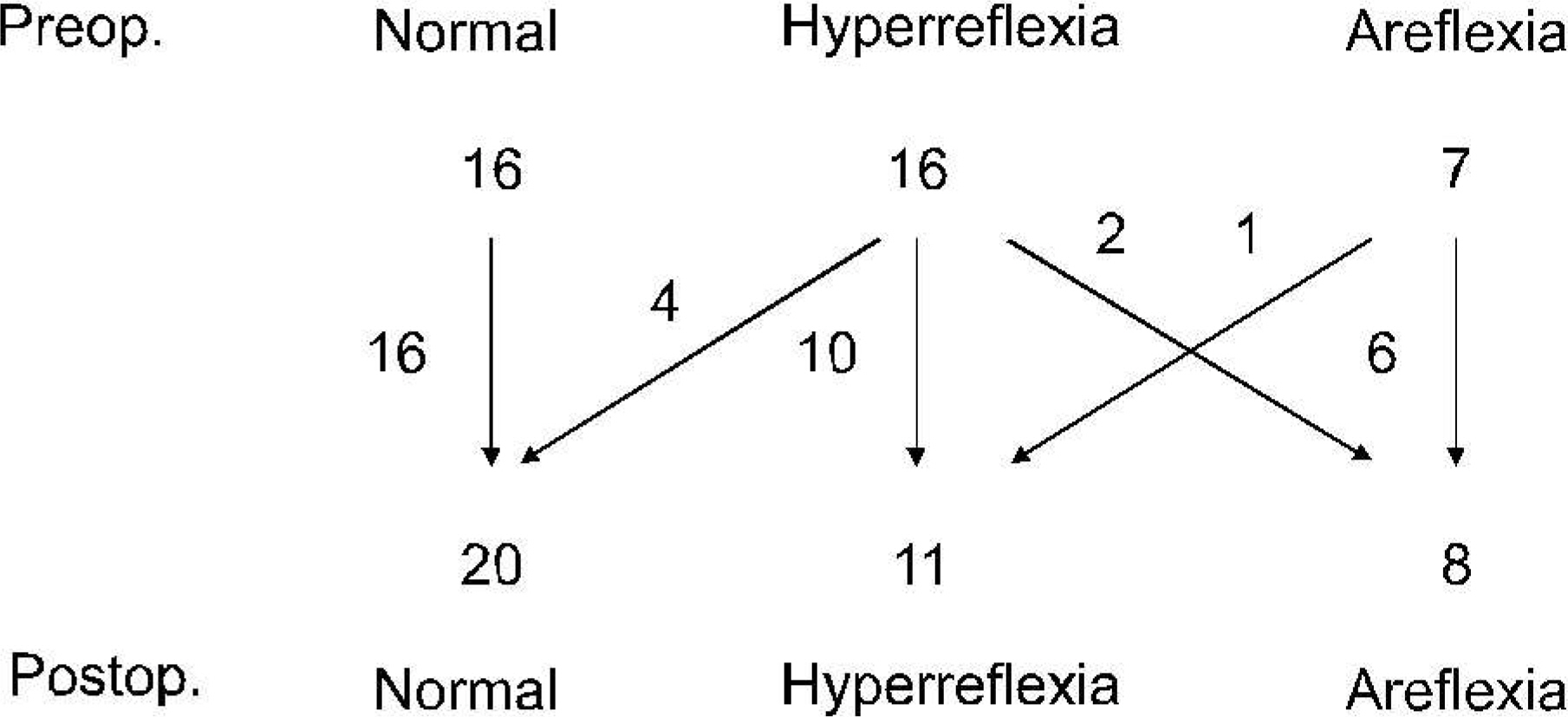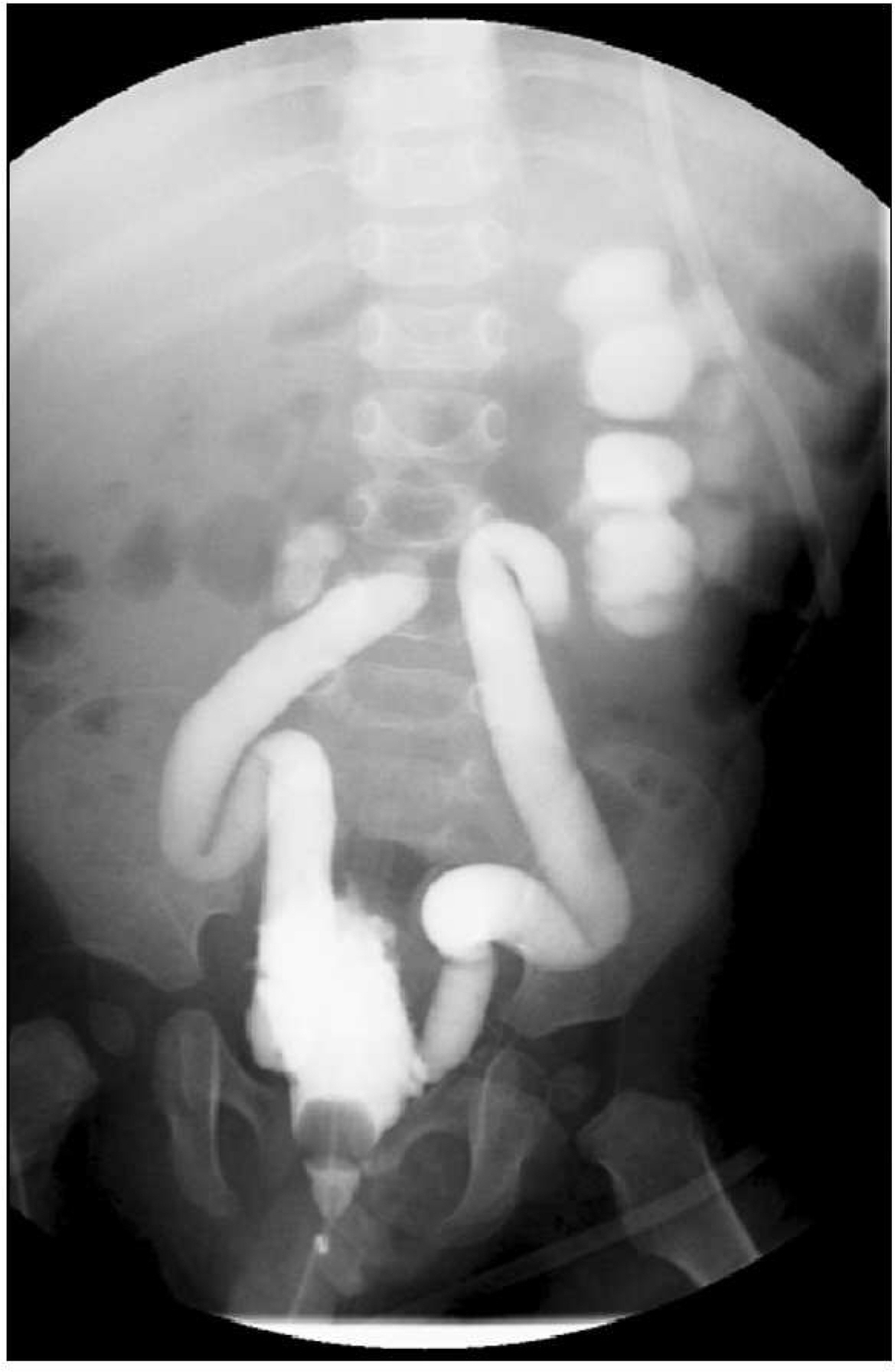Korean J Urol.
2007 Apr;48(4):452-457. 10.4111/kju.2007.48.4.452.
The Change of Bladder Function after Neurosurgery in Patients with Lipomyelomeningocele
- Affiliations
-
- 1Department of Urology, Ulsan University Hospital, University of Ulsan College of Medicine, Ulsan, Korea.
- 2Department of Neurosurgery, Asan Medical Center, University of Ulsan College of Medicine, Seoul, Korea.
- 3Department of Urology, Chuncheon Sacred Heart Hospital, College of Medicine, Hallym University, Chuncheon, Korea.
- 4Department of Urology, Asan Medical Center, University of Ulsan College of Medicine, Seoul, Korea. kskim2@amc. seoul.kr
- KMID: 1997115
- DOI: http://doi.org/10.4111/kju.2007.48.4.452
Abstract
- PURPOSE
To prevent further neurological deterioration by tethering of the spinal cord, an early surgical procedure for asymptomatic lipomyelomeningocele (LMMC) can be performed. The neurogenic bladder patterns, degree of improvement according to timing of surgery, and the relationship between the change in the upper urinary tract and neurogenic bladder pattern were evaluated.
MATERIALS AND METHODS
A retrospective chart review was performed on all 39 patients, before and after primary neurosurgical repair of LMMC, who presented between 1996 and 2003.
RESULTS
Preoperative urodynamics (UDS) revealed a neurogenic bladder in 23 patients (59%). Of these 23 patients, 16 had a hyperreflexic and 7 an areflexic bladder. Of the 16 who had a hyperreflexic bladder, 4 and 2 were changed to normal and areflexic bladders, respectively, but 10 remained unchanged postoperatively. In 3 patients repeated UDS was performed, with 1 remaining unchanged, but 2 changed to an areflexic bladder. Of the 7 patients with an areflexic bladder, 1 changed to a hyperreflexic bladder, but 6 remained unchanged postoperatively. All 3 patients who underwent a repeated UDS remained unchanged. Hydronephrosis was noted on ultrasonography in 3 patients. The degree of improvement according to the timing of surgery was not statistically significant. All 16 patients who had a normal bladder remained unchanged postoperatively, and 2 patients who underwent repeated UDS changed to a hyperreflexic bladder.
CONCLUSIONS
Even when pre- and postoperative UDS reveal a normal bladder function, long-term follow-up through UDS is still required. The use of routine preoperative and periodic postoperative urodynamic evaluations is important in children with LMMC, but without clinically overt symptoms.
Keyword
MeSH Terms
Figure
Reference
-
1.Hoffman HJ., Taecholam C., Hendrick 抑., Humphreys RP. Management of lipomeningoceles. Experience at the hospital for sick children, Toronto. J Neurosurg. 1985. 62:1–8.2.Fone PD., Vapnek JM., Litwiller 況., Couillard DR., McDonald CM., Boggan JE, et al. Urodynamic findings in the tethered spinal cord syndrome: does surgical release improve bladder function? J Urol. 1997. 157:604–9.
Article3.Gross AJ., Michael T., Godeman F., Weigel K., Huland H. Urological findings in patients with neurosurgically treated tethered spinal cord. J Urol. 1993. 149:1510–1.
Article4.Houser EE., Bartholomew TH., Cookson MS., Marlin AE., Little NA. A prospective evaluation of leak point pressure, bladder compliance and clinical status in myelodysplasia patients with tethered spinal cords. J Urol. 1994. 151:177–80.
Article5.Yoneyama T., Fukui J., Ohtsuka K., Komatsu H., Ogawa A. Urinary tract dysfunctions in tethered spinal cord syndrome: improvement after surgical untethering. J Urol. 1985. 133:999–1001.
Article6.Kang JK., Lee KS., Jeun SS., Lee IW., Kim MC. Role of surgery for maintaining urological function and prevention of retethering in the treatment of lipomeningomyelocele: experience recorded in 75 lipomeningomyelocele patients. Childs Nerv Syst. 2003. 19:23–9.
Article7.Koff SA. Estimating bladder capacity in children. Urology. 1983. 21:248.
Article8.Fairhurst JJ., Rubin CM., Hyde I., Freeman NV., Williams JD. Bladder capacity in infants. J Pediatr Surg. 1991. 26:55–7.
Article9.Kaefer M., Zurakowski D., Bauer SB., Retik AB., Peters CA., Atala A, et al. Estimating normal bladder capacity in children. J Urol. 1997. 158:2261–4.
Article10.Lapides J., Diokno AC., Silber SJ., Lowe BS. Clean, intermittent self-catheterization in the treatment of urinary tract disease. J Urol. 1972. 107:458–61.
Article11.Bomalaski MD., Teague JL., Brooks B. The long-term impact of urological management on the quality of life of children with spina bifida. J Urol. 1995. 154:778–81.
Article12.Wu HY., Kogan BA., Baskin LS., Edwards MS. Long-term benefits of early neurosurgery for lipomyelomeningocele. J Urol. 1998. 160:511–4.
Article13.McGuire EJ., Woodside JR., Borden TA., Weiss RM. The prognostic value of urodynamic testing in myelodysplastic patients. J Urol. 1981. 126:205–9.14.Flanigan RC., Russell DP., Walsh JW. Urologic aspects of tethered cord. Urology. 1989. 33:80–2.
Article15.Kaplan WE., McClone DG., Richards I. The urological manifestations of the tethered spinal cord. J Urol. 1988. 140:1285–8.
Article16.Bruschini H., Almeida FG., Srougi M. Upper and lower urinary tract evaluation of 104 patients with myelomeningocele without adequate urological management. World J Urol. 2006. 24:224–8.
Article17.Palmer LS., Richards I., Kaplan WE. Subclinical changes in bladder function in children presenting with nonurological symptoms of the tethered cord syndrome. J Urol. 1998. 159:231–4.
Article18.Bruce DA., Schut L. Spinal lipomas in infancy and childhood. Childs Brain. 1979. 5:192–203.
Article19.Hellstrom WJ., Edwards MS., Kogan BA. Urological aspects of the tethered cord syndrome. J Urol. 1986. 135:317–20.
Article20.Foster LS., Kogan BA., Cogen PH., Edwards MS. Bladder function in patients with lipomyelomeningocele. J Urol. 1990. 143:984–6.
Article21.Keating MA., Rink RC., Bauer SB., Krarup C., Dyro FM., Winston KR, et al. Neurourological implications of the changing approach in management of occult spinal lesions. J Urol. 1988. 140:1299–301.
Article22.Satar N., Bauer SB., Scott RM., Shefiaer J., Kelly M., Darbey M. Late effects of early surgery on lipoma and lipomeningocele in children less than 1 year old. J Urol. 1997. 157:1434–7.
Article23.Kothari MJ., Bauer SB., Logigian EL., Shefner JM. Electrophy-siological and urodynamic studies to monitor surgical outcome in children with tethered spinal cords. Muscle Nerve. 1995. 18:1373–7.
Article
- Full Text Links
- Actions
-
Cited
- CITED
-
- Close
- Share
- Similar articles
-
- Coexistence of Subcutaneous Dermoid Cyst and Lipomyelomeningocele
- The Factors That Affect Improvement of Neurogenic Bladder by Severe Lumbar Disc Herniation in Operation
- Surgical Treatment of Lipomyelomeningocele
- Lipomyelomeningocele: Clinical analysis of 14 Cases
- Tethered Cord Syndrome in Adulthood: Reconsidering the Prognosis




